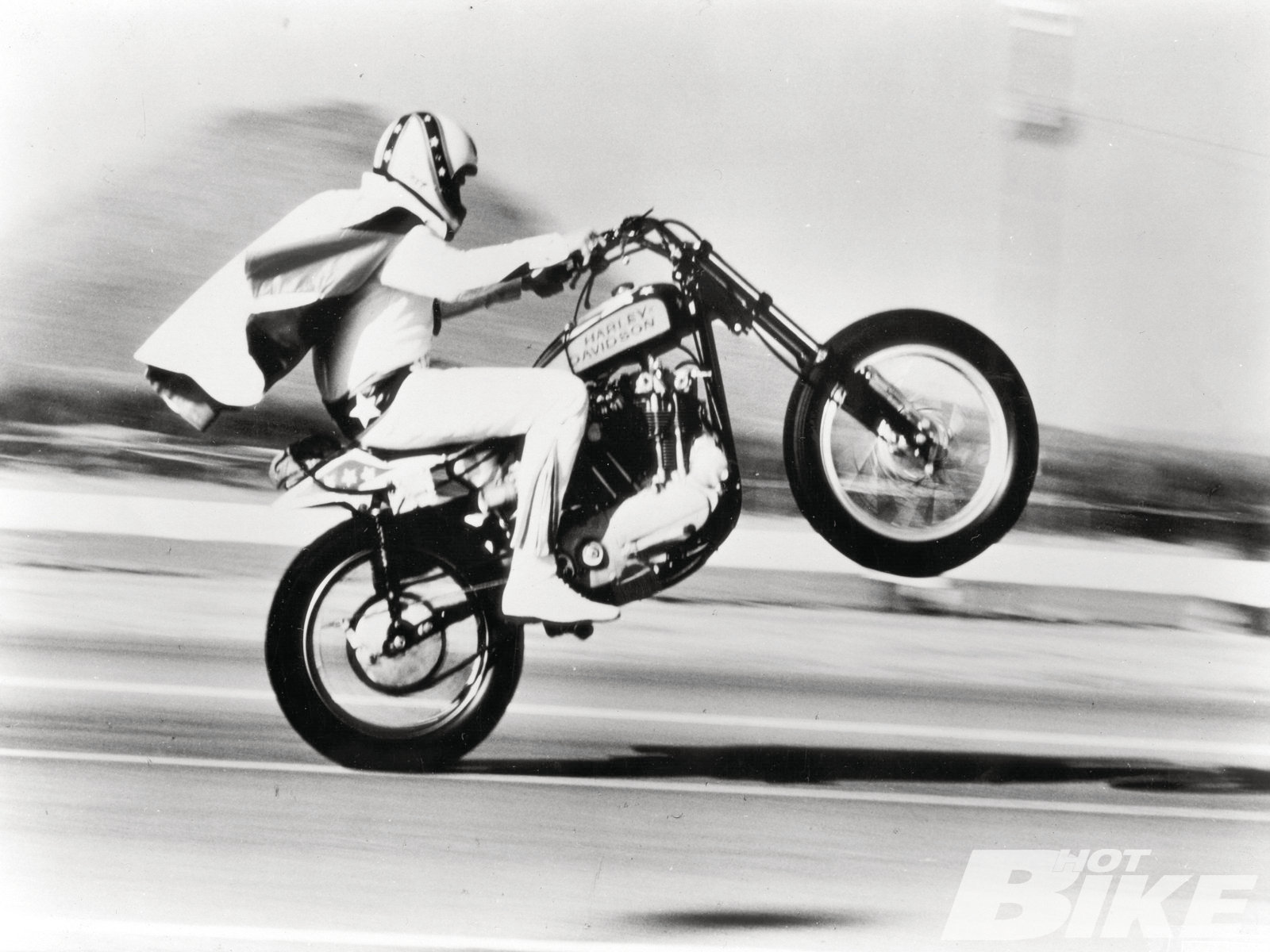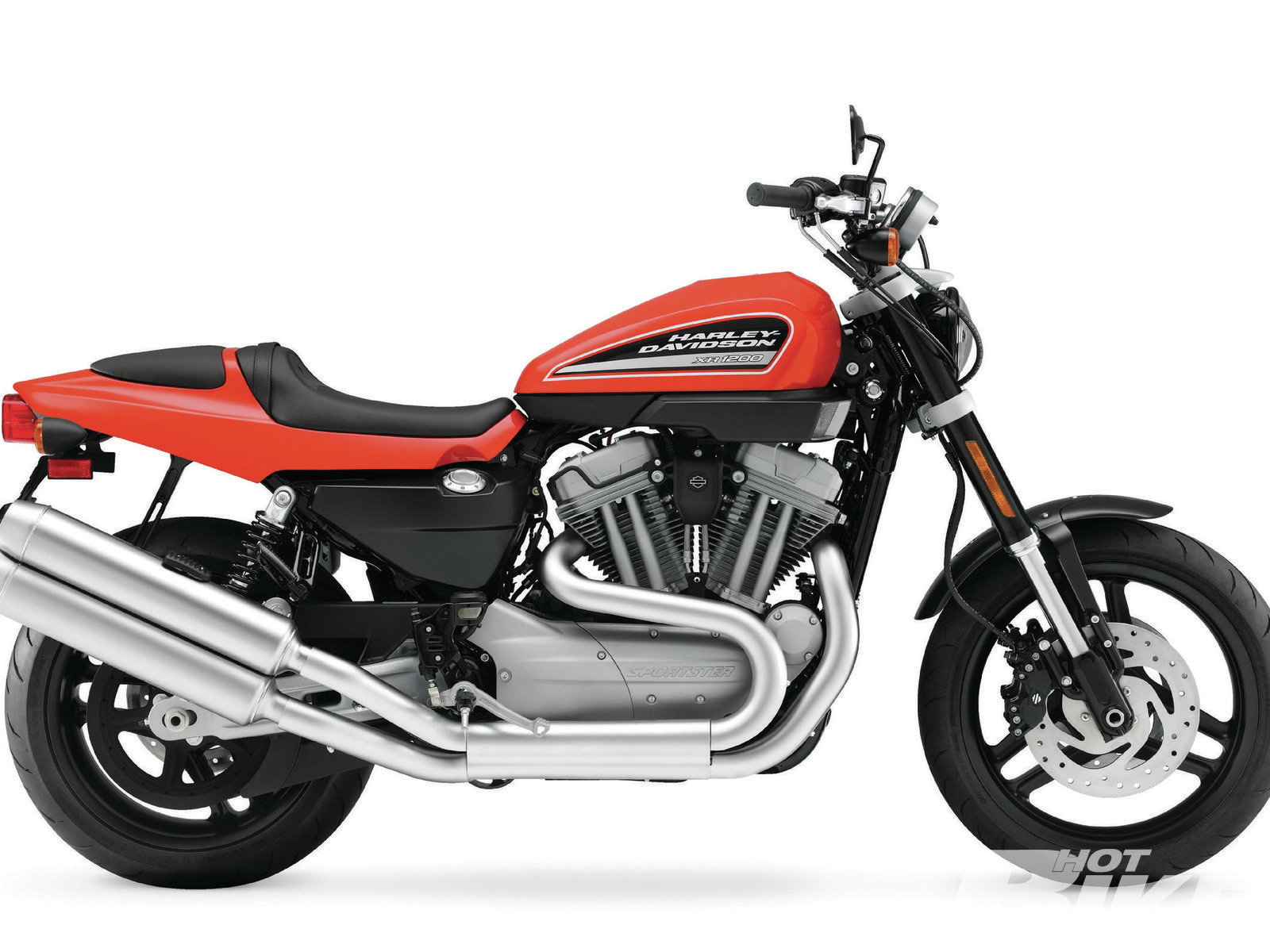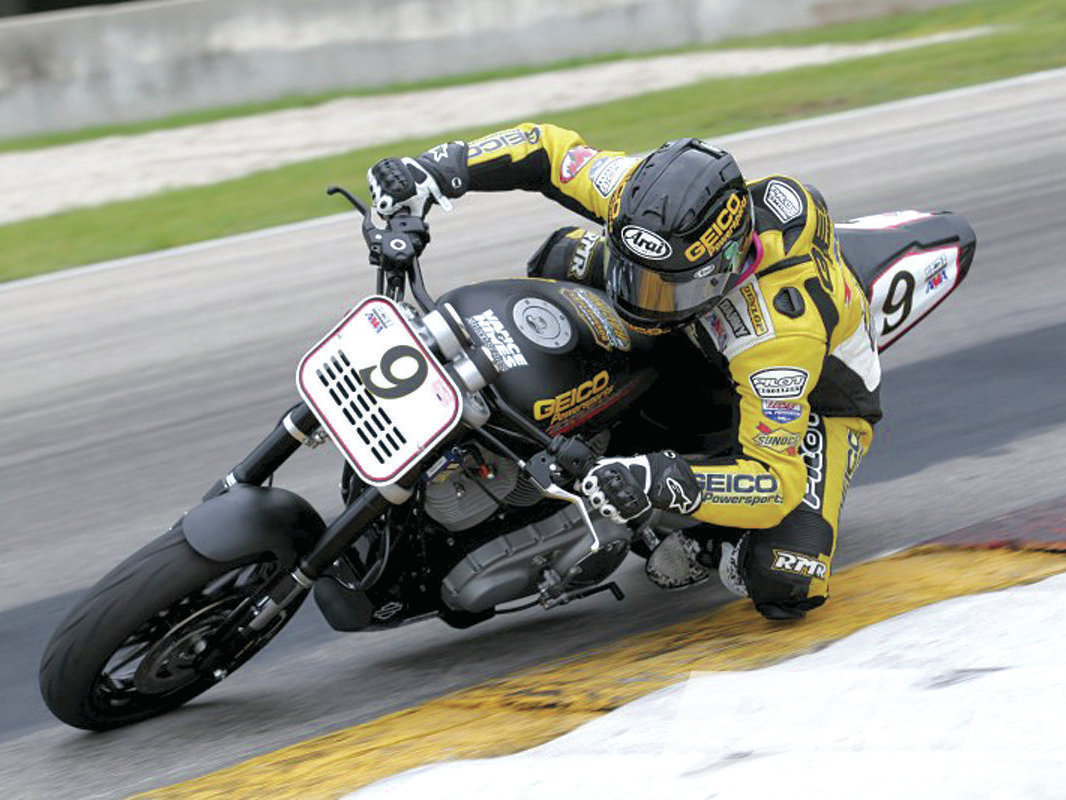XR Racing: Can Your Sports Dynasty Do This?


Smart, passionate as hell, and driven to match, Dick O’Brien ran Harley’s racing program for 26 years, as seen in this factory race team photo from 1981. His input was key in making the XR happen, and the pilots he chose for it were some of the most talented motorcycle racers in history. L to R: Bill Werner, Jay Springsteen, Dick O’Brien, Randy Goss, and Brent Thompson.

A racing XR-750 from back in the day. It’s a bare-bones machine with minimal weight.


In fact, the XR-750 is such a famous part of Harley’s history that the manufacturer gave a nod to it in 2001 when it launched the 883R—a stock Sportster with XR-750 paint (one of which sits in my gara..



A picture, or better yet advertisement, is worth a thousand words.

In 2009, Harley introduced the XR1200 homage bike to the American public where it met great enthusiasm from the H-D faithful. Unlike the old 750, it has a few more comforts for the road and features a Sportster motor.


With Harley putting so much effort into its new XR-styled Sportsters, we thought it might be a good plan to take a brief journey into the dirt racing history of the XR-750. In all the world of pro sports, how many competitors can claim a dynasty lasting nearly four decades like Harley can with its XR-750?
The alloy XR-750 that we know first took to the track in 1972 but its story starts more than 30 years earlier and continues to this day. Our story starts in the ’30s when the AMA created the 750cc Class C racing class. With the Great Depression going strong, the motorcycle industry needed to promote sales of standard motorcycles. The AMA created the Class C to do just that—program rules only permitted bikes built in serial production for normal highway use. As a result, thousands of private racers stepped out of the woodwork for a shot at a title. Harley 750cc V-twins raced in it from the get-go and the XR was eventually created to keep H-D competitive in the class.
Later, Harley’s race team dominated the AMA Grand National Series between 1954 and 1966 thanks mainly to H-D racing directors Hank Syversten, Dick O’Brien, and the succession of great riders that made up Harley’s second Wrecking Crew. If anyone can be called the “Father of the XR” it would be O’Brien. Born in New York in 1921, he grew up in St. Petersburg, Florida. He had a lifelong fascination with all things mechanical, doing odd jobs to buy junker cars and motorcycles as he grew up. That turned him into a highly skilled, self-trained mechanic. Later he landed a job at Puckett Motors, a Harley-Davidson dealership in Orlando, where his duties included building racing engines.
Hank Syversten, Harley mechanic and racing chief since the ’20s, hired O’Brien as his own replacement in 1957. O’Brien learned the ropes very quickly, watching and listening to everything that went on at the track. Which, as it turned out, was a damn good thing for Harley.
When Dick O’Brien took over in the ’50s, foreign brands were already stepping up to challenge H-D’s dominance at the track. With the ’60s, the AMA yielded to pressure from foreign bike owners, dealers, and fans to relax the Class C rules, permitting more parts made specifically for racing. When Triumph’s Gary Nixon won back-to-back AMA Grand National Championships in 1967 and 1968, the writing was on the wall: Harley’s Class-C KRTT needed to be put to pasture in favor of new blood.
Fortunately, O’Brien was equal parts drive, resourcefulness, and strategist. He’d seen the storm coming and started making adjustments as events unfolded. Cal Rayborn and Mert Lawwill, two of the biggest legends in Harley history, rode iron for H-D at that time. There was still something lacking, though. Good talent can keep a race team competitive but even the best talent won’t make you dominant on obsolete motorcycles. What Harley really needed was a new race bike.
The new machine was loosely based on the company’s street Sportster but had dual carbs, special heads with the exhaust ports up front and the intake ports at their rear, and a megaphone exhaust mounted up high.
It also had a bit of a weight problem. It wasn’t obese, but it definitely needed less iron in its diet. Introduced in 1970, the ironhead XR 750 was just a bandage to stop the bleeding; the real solution to Harley’s racing woes came two years later. Dutch racer Peter Zylstra had been added to Harley’s design team in 1969 after emigrating from Holland. He’d road raced a Manx Norton in Europe and was recruited by Foster Uskalio, who ran Harley-Davidson’s engineering design and draft department. Zylstra’s input as a designer was key to the XR’s development. Among the improvements were alloy barrels replacing the iron ones. With other alloy components swapped in, the revamped XR-750 was a completely different animal. It was a leaner, angrier animal that would carry its jockeys to victory time and again, beyond the dreams of its creators.
The new bike made its debut in 1972 where it instantly spanked the competition. By year’s end, Mark Brelsford won the Grand National Championship astride his factory XR-750. That was the start of one of the longest (if not the longest) dynasties in professional sports.
What’s more, the XR-750 was possibly the brightest spot in the dark years Harley spent under AMF’s yoke. While the rest of the company fell sick around it, Harley’s factory team, and Mert Lawwill’s prominence in the film On Any Sunday, put a positive face on a bad situation. It was also during this time that Cal Rayborn, Mert’s fellow factory racer, won two nationals and brought Harley its last AMA Grand National road race win.
Unfortunately, Rayborn died in a club event in New Zealand in December of 1973 and an inner ear problem forced Mert into retirement as a racer in 1977. They passed the torch to a new generation of riders like Jay Springsteen, Scott Parker, and, after Harley divorced itself from AMF, Chris Carr. They, as much as anyone else, kept the XR-750 dynasty alive and well far beyond anyone’s expectations.
It wasn’t always easy, though. In the mid-’80s Harley-Davidson was struggling just to stay alive and rumors floated that the racing team would get axed at any time. Indeed, the factory program was outsourced for a few years, forcing Scott Parker to hire Harley-Davidson mechanic Bill Werner as his tuner.
After Harley’s execs bought the company from AMF though, things got a whole lot better. Harley-Davidson renewed the factory flat track program, keeping the XR’s legacy alive and well. In fact, the XR-750 is such a famous part of Harley’s history that the manufacturer gave a nod to it in 2001 when it launched the 883R—a stock Sportster with XR-750 paint (one of which sits in my garage). The nod to nostalgia proved so popular Harley created the XR1200, launching it first in Europe, then here in the US in 2009.
Even that wasn’t enough for some XR fans, though. If the old XR-750 could still tear it up at the track, why not set up a competition for the XR1200? In 2010, Vance & Hines got together with the AMA to do just that, on pavement however. No one can say what the future holds but with such a great legacy behind it, the XR1200 series is off to a great start. HB
Evel Knievel
The XR-750 was also the bike of choice for one of the most famous riders in the history of motorcycling, and he wasn’t even known for his racing ability. His name: Evel Knievel. Between 1965 and 1980, Evel Knievel (aka Robert Craig Knievel) attempted over 75 ramp-to-ramp motorcycle jumps as well as a jump across the Snake River Canyon in 1974. The 37 broken bones he suffered during his career earned an entry in the Guinness Book of World Records as the survivor of “most bones broken in a lifetime.” Knievel died of pulmonary disease in Clearwater, Florida, at age 69. He was inducted into the Motorcycle Hall of Fame in 1999.
The Right Stuff
Here are some of the most notable XR-750 pilots, covering the full range of its glorious history.
Cal Rayborn: Not only did he win 11 AMA nationals in seven years, Cal also held a land speed record. In 1972 he ventured across the pond where he rode his XR-750 in the Transatlantic Match races, capturing three of the six races, and tying as top scorer in the series. Rayborn raced with Harley-Davidson his entire career.
Mert Lawwill: He was the American Motorcyclist Association Grand National Champion of 1969 and one of the top professionals on the AMA national circuit during ’60s and ’70s. Harley-Davidson signed him to the factory team in 1964. Lawwill won his first AMA national at the Sacramento Mile on September 19, 1965. It was the first of 15 career wins for him. In 1969, Lawwill was voted the AMA’s Most Popular Rider of the Year. When he retired in 1977, he had claimed 161 career AMA Grand National finishes during his 15-year racing career.
**Jay Springsteen: **In 1975 Jay announced his presence with authority by earning the AMA Rookie of the Year Award. It was the beginning of a long line of flat track conquests; by the time he was done, Springsteen was a three-time AMA Grand National Champion with more than 40 National Championship flat track race wins to his credit. He’s considered one of the best AMA Grand National flat-track racers of all time. Between 1975 and 2003, he created the longest racing career in AMA Grand National history. Springsteen was a factory rider with Harley-Davidson for much of his career and was perhaps the racer most closely associated with the American brand in the ’70s and beyond. In total, he raced in a record 398 AMA nationals, winning a total of 43.
Scott Parker: A nine-time AMA Grand National Champion, Parker holds an all-time record 94 Grand National Championship race wins, including 55 AMA National Mile wins, and 35 AMA Half-Mile wins. He is also a three-time winner of AMA Pro Athlete of the Year. Parker, who rode for the factory Harley-Davidson flat track team for most of his career, was considered the undisputed King of the Mile. His 55 career wins on mile flat tracks was more than double that of his nearest competitor. He was also the leader in wins on half-miles. Parker won on all forms of flat track competition—miles, half-miles, short track, and TT Steeplechase.
Tammy Kirk: She wasn’t on the factory team, but her pink XR-750 stood out with the best of them at the races. In 1983, Tammy Kirk became the first woman in history to reach a Grand National Championship final when she earned a spot in the Knoxville Half Mile event. In 1986, she made history by winning a Class C flat track race in Knoxville, Tennessee. Later she jumped over to NASCAR racing. In 1994, she was named the Most Popular Driver in NASCAR’s Slim Jim All Pro Series, and would finish sixth in that series’ points two years later. Kirk became the second woman to win a NASCAR touring series event when she won the 1994 Snowball Derby.
The Original Wrecking Crew
In 1968 Harley’s factory team posed for a photo at Daytona, instantly drawing comparisons to a similar shot taken of H-D’s original Wrecking Crew of the ’20s. The original Crew consisted of Bill Ottoway, Maldwyn Jones, Ralph Hepburn, Fred Ludlow, Otto Walker, Ray Weishaar, Jim Davis, and mechanic Hank Syversten. Ottoway was a racing engineer who developed the eight-valve racing engine for Harley-Davidson and made the already fast bikes even faster. The crew dominated flat track and board track throughout the ’20s.
The XR1200 Series:
The Adventure Continues
Last year, the XR’s racing legacy moved forward yet again. The AMA Pro Vance & Hines XR1200 series hit the track during Road America last June. It was a set of five racing events on pavement that ran through September. Vance & Hines was the presenting sponsor. They also supplied the race kits for the class (exhaust, Fuelpak, bodywork, 17-inch front wheel, steering damper, oil cooler relocator, and race decals). V&H cited the XR1200’s proven record as an exciting platform for spec racing in Europe as a big reason for its involvement. Since the complete race kit ran for $3,500, it allowed new talent to compete without the use of a second mortgage or a loan shark. In addition to the supplied kit, teams could also tweak their suspension, controls, brakes, and instrumentation. The restrictions are aimed to emphasize rider talent over throwing money into a heap of performance parts. Here’s when and where you can catch the action for the remaining season:
May 13-15
Infineon Raceway
May 28-30
Miller Motorsports Park
Jun 3-5
Road America
Jun 17-19
Barber Motorsports Park
Jul 8-10
Mid-Ohio Sports Car Course
Aug 12-14
Virginia Int’l Raceway
Sept 2-4
New Jersey Motorsports Park
(An additional September event— To be determined)
Sources
AMA Motorcycle Hall of Fame (americanmotorcyclist.com) Harley-Davidson Archives
Heroes of Harley-Davidson, edited by Ed Youngblood, published by MBI Publishing Company and Motorbooks, 2003
The Harley-Davidson Motor Company Archive Collection, by Randy Leffingwell and Darwin Holmstrom, published by MBI Publishing Company and Motorbooks, 2008







